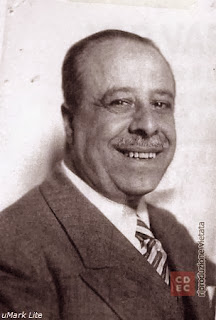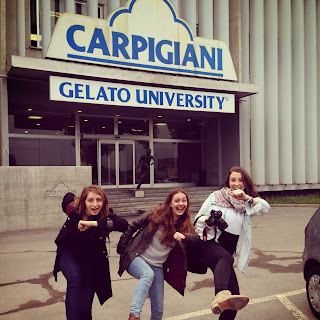Rome is full of huge reminders of the city's ancient past; statues, ruins and buildings all jump out at you, begging to be noticed and admired. But even the quietest streets have stories to tell.
I walk the same route to and from work every day, but it took me two weeks to notice two golden squares among the cobbles of one street. It was raining, so I was keeping my head down, and then I saw them - sort of glinting against a background of grey. So I stopped to look, wondering if they were part of an art installation, or gave information about the building they were placed outside.
The stones are a memorial. They each sum up a life in very few words, haiku-like in their simplicity. 'Here lived Lionello Alatri' reads one; the other is for his wife Evelina. Three dates follow; the date they were born, the date they were deported (to Auschwitz), the date they were murdered.
I walk the same route to and from work every day, but it took me two weeks to notice two golden squares among the cobbles of one street. It was raining, so I was keeping my head down, and then I saw them - sort of glinting against a background of grey. So I stopped to look, wondering if they were part of an art installation, or gave information about the building they were placed outside.
The stones are a memorial. They each sum up a life in very few words, haiku-like in their simplicity. 'Here lived Lionello Alatri' reads one; the other is for his wife Evelina. Three dates follow; the date they were born, the date they were deported (to Auschwitz), the date they were murdered.
I found out later that the stones form just a tiny part of a project spanning eight countries, with over 40,000 stones and 84 in Rome. Each commemorates a Holocaust victim, with a simple inscription on the gold-plated stone outside the person's former home.
The artist behind it, Cologne-born Gunter Demning, wanted to give back a name to the victims who had been reduced to a number, returning them symbolically to the home and neighbourhood that was snatched from them.
They are called Stumbling Stones, Stolpersteine in German, because the idea is that you literally stumble over the slightly raised cobbles, and are forced to remember. Demning says that stooping down to read the details is a kind of bow of respect to the victims.
Today the apartment block where the Alatri's lived is an office building. It's in one of Rome's priciest districts, full of businessmen in suits who seem to be in too much of a rush to notice two golden cobblestones.
I found a website with information about Rome's Holocaust victims, where I found out Lionello had dedicated much of his life working for Jewish institutions, and helped many Jewish refugees who fled to Rome from countries under Nazi control. He also owned a textiles business, but was forced to resign once Italy's racial laws came into force. Shortly afterwards, he and Evelina were taken from their home and deported to Auschwitz. After the week-long journey, they were judged unfit to work on arrival, and were both gassed to death.
It also contains a copy of the last letter Lionello wrote, which was thrown out of the train window and later found by a railway worker. Most of it is very matter-of-fact, and even optimistic. It opens with the words 'We are leaving for Germany' and goes on to explain how much the landlord was to be paid each month for light and gas bills, and various other financial affairs to be put in order.
He tells the reader 'I ask whoever finds this letter, for the sake of humanity, please do these things. Keep courage, like we are.' The letter ends with a sudden burst of emotion: 'I am dismayed.'
He tells the reader 'I ask whoever finds this letter, for the sake of humanity, please do these things. Keep courage, like we are.' The letter ends with a sudden burst of emotion: 'I am dismayed.'


















.JPG)
.JPG)
.JPG)































